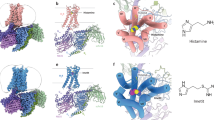Abstract
Dimaprit, S-[3-(N,N-dimethylamino)propyl]isothiourea, appears to be a highly specific histamine H2-receptor agonist. Further indications of specificity are obtained from chemical considerations. Dimaprit has two basic centres (pK a values respectively 8.23 and 9.23, at 40°.) and at pH 7.4 about 5% of the molecules will be present as the monocation analogous to histamine monocation. Chemical comparison suggests that the −N+HMe2 group corresponds to the −N+H3 of histamine, and that the isothiourea group of dimaprit (which can undergo 1,3-prototropic tautomerism) may simulate the imidazole ring of histamine and function as a proton transfer agent at H2 receptors.
Simple structural analogues of dimaprit are only weakly active, indicating a high degree of chemical specificity for H2-receptor stimulation; such compounds (e.g. the lower homologue, SK & F 91487) may serve as useful chemical controls when studying the actions of dimaprit.
Similar content being viewed by others
References
M.E. Parsons, D.A.A. Owen, C.R. Ganellin andG.J. Durant,Dimaprit-[S-[3-(N,N-dimethylamino]-propyl]isothiourea] — A Highly Specific Histamine H 2-Receptor Agonist. Part 1. Pharmacology, Agents and Actions7, 31–37 (1977).
J.W. Black, W.A.M. Duncan, G.J. Durant, C.R. Ganellin andM.E. Parsons Definition and Antagonism of Histamine H 2-receptors, Nature, Lond.236, 385–390 (1972).
G.J. Durant, C.R. Ganellin andM.E. Parsons,Chemical Differentiation of Histamine H 1-and H 2-Receptor Agonists, J. Med. Chem.18, 905–909 (1975).
M.J. Graham of these laboratories; personal communication.
E.S. Pepper of these laboratories; personal communication.
C.H. Stam,The Crystal Structure of S-Methylisothiourea Sulphate [CH 3 SC(NH 2)2] +2 SO 2−4 , Acta Cryst.15, 317–322 (1962).
For histamine numbering seeJ.W. Black andC.R. Ganellin,Naming of Substituted Histamines, Experientia30, 111–113 (1974).
K. Prout, S.R. Critchley andC.R. Ganellin,2-(4-Imidazolyl)-ethylammonium Bromide (Histamine Monohydrobromide), Acta Cryst.B30, 2884–2886 (1974).
R.G. Jones,Chemistry of Histamine and Analogs. Relationship between Structure and Pharmacological Activity, in:Histamine and Antihistamines, Part 1, Vol. XVIII/I, pp. 1–53, Handb. Exp. Pharmacol., Eds. O. Eichler and A. Farah, Springer-Verlag, New York, 1966.
N.J. Kartinos, U.S. Patent 3,116,327 (1963).
C.A. Buehler, H.A. Smith, A.C. Kryger, R.L. Wells andS.F. Thames,Physiologically Active Compounds. V. Aminothiol Esters of Substituted Acetic, Chloroacetic, Benzilic, and Related Acids, J. Med. Chem.6, 230–233 (1963).
R.R. Renshaw, P.F. Dreisbach, M. Ziff andD. Green,Thioesters of Choline and β-Methylcholine and their Physiological Activity. Onium Compounds. XIX, J. Am. Chem. Soc.60, 1765–1770 (1938).
A.L. Morrison andK.J.M. Andrews describe dihydrochloride, Brit. Patent 690,576 (1953); Chem. Abstr.48, 7046f.
Prepared byD.R. Hollyman of these laboratories from N-methylthiourea and 3-chloropropyldimethylamine hydrochloride in refluxing ethanol. C7H17N3S, 2HCl, m.p. 144–146°., (from ethanol-petroleum).
J.H. Short, U. Biermacher, D.A. Dunnigan andT.D. Leth,Sympathetic Nervous System Blocking Agents. Derivatives of Guanidine and Related Compounds, J. Med. Chem.6, 275–283 (1963).
C.R. Ganellin,Conformation of Histamine Derivatives. 3. A Relationship between Conformation and Pharmacological Activity, J. Med. Chem.16, 620–623 (1973).
Author information
Authors and Affiliations
Rights and permissions
About this article
Cite this article
Durant, G.J., Ganellin, C.R. & Parsons, M.E. Dimaprit, [S-[3-(N,N-dimethylamino)propyl]isothiourea]. A highly specific histamine H2-receptor agonist. Part 2. Structure-activity considerations. Agents and Actions 7, 39–43 (1977). https://doi.org/10.1007/BF01964879
Received:
Issue Date:
DOI: https://doi.org/10.1007/BF01964879




